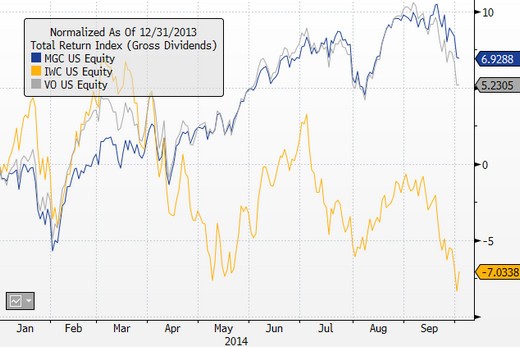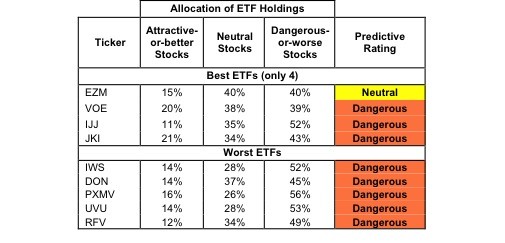The Best MidCap ETFs
Post on: 18 Июль, 2015 No Comment

Pop quiz: Which corner of the domestic stock market has seen the highest returns in the past 15 years — small-caps or large-caps? The answer is neither! Mid-cap stocks have actually outperformed both their smaller and larger competition in that timeframe. While the small-cap-focused Russell 2000 Index has posted a 7.7% annualized 15-year return and the S&P 500 clocks in with a 6.9% showing, the Russell Midcap Index has produced a 9.9% annualized gain.
That means investors who are giving short shrift to the midsection of the domestic stock market are likely leaving money on the table. There are a handful of first-rate actively-managed mutual funds that focus on the mid-cap market, but it can be very difficult for the average investor to identify those funds, and even more difficult to stick with them during their inevitable periods of underperformance. So if you’re not up for the game of trying to out-guess the market, exchange-traded funds are probably a safe bet for you. Fortunately, there are some very inexpensive and well-diversified mid-cap funds out there that you can draw on.
Finding middle ground
If you’re looking to gain exposure to a wide swath of the mid-cap market, two of the cheapest options on the market are Schwab U.S. Mid-Cap ETF ( NYSE: SCHM ) and Vanguard Mid-Cap ETF ( NYSE: VO ). These two funds will only set you back 0.13% and 0.14% a year, respectively. While the Schwab fund is fairly new and tracks the Dow Jones U.S. Mid-Cap Total Stock Market Index, the Vanguard fund, which tracks the MSCI US Mid Cap 450 Index, has been around since 2004. The index fund version of the ETF goes back 13 years, to 1998. Either fund would make a solid core mid-cap holding for any investor’s portfolio.
Two other solid options with slightly longer track records are iShares Russell Midcap ETF ( NYSE: IWR ) and SPDR S&P MidCap 400 ETF ( NYSE: MDY ). The SPDR fund has more than $12 billion in net assets, while the iShares fund has roughly $6.6 billion to its name. Although these two funds cost a tad bit more than the Schwab and Vanguard funds, with annual price tags of 0.20% and 0.25% respectively, their larger asset base will likely provide more liquidity to investors. This translates into lower bid-ask spreads and smaller potential discrepancies between the fund’s net asset value and the underlying assets. And while all four funds track different market indexes, performance among the ETFs is fairly comparable.
Digging deeper
Of course, if you want to zero in more closely on a certain segment in the mid-cap space, there are style-specific ETFs that you might want to consider. If you’re a value-seeker, two good options are the Vanguard Mid-Cap Value ETF ( NYSE: VOE ) and the iShares S&P MidCap 400 Value ETF ( NYSE: IJJ ). Both funds invest in those companies within their respective mid-cap indices that are the most value-oriented, based on measures such as price-to-book ratios, dividend yield, price-to-sales ratios, and forward earnings-to-price ratios. The Vanguard fund costs 0.14%, while the iShares fund charges 0.28%.
For investors looking to home in on more growth-oriented securities, Vanguard Mid-Cap Growth ETF ( NYSE: VOT ). with its 0.14% expense ratio, or iShares S&P MidCap 400 Growth ETF ( NYSE: IJK ) at 0.25%, are decent options. Here, growth factors, including sales growth, momentum, and price-to-earnings-change ratios are examined to extract the most growth-leaning companies in the mid-cap index each fund tracks. In general, growth stocks have been laggards over the past decade, but odds are good that they will come back into favor at some point in the current market cycle, so don’t count this sector out just yet.

The past is not the future
And while all diversified investors should have at least some mid-cap exposure, whether through a dedicated mid-cap mutual fund or through owning small- and large-cap funds that stray over into mid-cap territory, folks should moderate their expectations for the future a bit. It’s not a sure bet that mid-caps will once again beat the pants off of small- and large-cap stocks over the next decade and half. In fact, because they have done so well in recent history, there is more of a chance that returns will moderate a bit going forward. In fact, I think it’s likely that large-caps will be the winner in the next few years.
However, over the long run, a solid mid-cap allocation is key to building an appropriately diversified portfolio. If you’re a more aggressive investor with several decades left until you need your money, a 15% dedicated mid-cap allocation is probably a good target to aim for. If you’re in retirement, a 5%-7% allocation is likely more appropriate. Whatever the right number is for you, make sure the middle ground of the market has adequate representation in your portfolio.
For more winning mutual fund recommendations and time-tested personal financial planning advice, check out the Fool’s Rule Your Retirement service. You can start your free 30-day trial today.
Amanda Kish is the Fool’s resident fund advisor for the Rule Your Retirement investment newsletter. At the time of publication, she did not own any of the funds or companies mentioned herein. Try any of our Foolish newsletter services free for 30 days . We Fools may not all hold the same opinions, but we all believe that considering a diverse range of insights makes us better investors. The Motley Fool has a disclosure policy .














